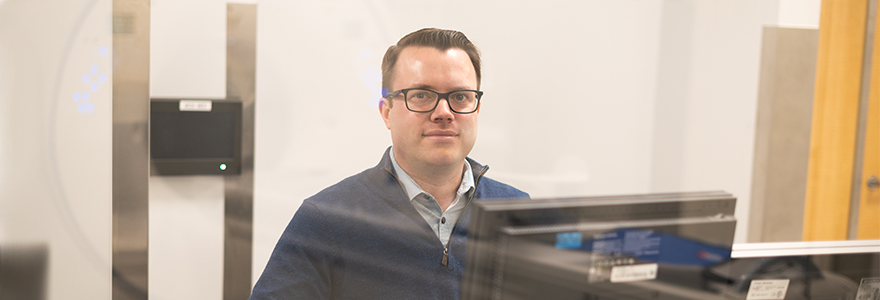Researcher examines new connections in helping implant patients
 A CT, reflected in the photo, is an important part of the work Matthew Teeter, PhD, will conduct on knee replacements thanks to an Arthritis Society Canada award.
A CT, reflected in the photo, is an important part of the work Matthew Teeter, PhD, will conduct on knee replacements thanks to an Arthritis Society Canada award.
By Cam Buchan
Matthew Teeter, PhD, is investigating the unusual connection between the gut and knee.
Thanks to a Stars Career Development Award from Arthritis Society Canada, Teeter and his team will combine medical imaging and biological research to find out how gut bacteria affect implant-bone healing.
The work will also examine if ongoing joint inflammation after knee replacement causes pain, and gain a better understanding of immune cell reactions in joint tissue caused by worn out components, said the associate professor in the departments of medical biophysics, surgery and medical imaging at Schulich School of Medicine & Dentistry and Robarts Research Institute scientist.
Total hip and knee replacements are the mainstay treatment for advanced osteoarthritis with more than 140,000 of these procedures performed annually in Canada. However, approximately 30 per cent of patients experience complications or dissatisfaction, and 10 per cent must undergo repeat surgeries to replace failed components.
Teeter’s research is out to improve those numbers.
“My lab’s mission is to enhance patient mobility and quality of life after joint replacement through the development and application of imaging and digital technologies,” said Teeter, who is also co-director of the imaging group at Robarts, and associate director of Western’s Bone and Joint Institute. “With this award, we will combine medical imaging and biological research approaches to evaluate new treatments that will help patients avoid complications and the need for repeat surgeries.”
This first-ever clinical study on the role of gut bacteria on bone growth around implants will lead to a trial evaluating the use of probiotics to improve the connection between bone and implant.
“The bacteria that live in your gut can influence bone reabsorption and healing. The bacteria themselves can produce vitamins that your bone needs to form more bone,” said Teeter.
There are some indications in current research that shows women with osteoporosis have a different gut microbiome than those without.
“We're interested in finding predictive factors to determine the type of implant patients should receive,” he said. “And potentially the microbiome is something we can influence. If you're undergoing surgery, maybe you should be taking a probiotic that might improve your bone health during that period when the bone is trying to grow into the implant.”
Through the funding, Teeter also hopes to help patients experiencing pain after surgery and determine if this pain is within the brain or from actual cellular activity in the joint.
Another area of investigation will look at implant integrity in relation to immune reactions in joints and identify possible screening tools.
“Understanding these risk factors and evaluating new treatments will help patients receive more personalized interventions that avoid complications and the need for repeat surgeries,” said Teeter.
With one-in-five knee implant patients dissatisfied after surgery, the new research could offer multiple benefits to patients.
“When surgery is first done, it takes a few weeks for the implant to settle in the bone and bone to grow,” said Teeter. “If we track the implant from the first weeks to two years after surgery, we can predict if it's becoming well fixed, and will last a long time, or whether it might be prone to early loosening requiring patients to undergo revision surgery.”
The work provides direction for new implant designs and introduces surgeons to new technologies, such as surgical robotics or navigation.
“Dissatisfied patients tend to back to the clinic or go to the pharmacy, requiring more health-care resources. They are also often prevented from doing the things they want to do in life because the joint hurts or doesn’t feel right,” said Teeter. “We’re trying to optimize everything about the procedures to restore the mobility patients had before having arthritis and provide better, pain-free mobility.”








